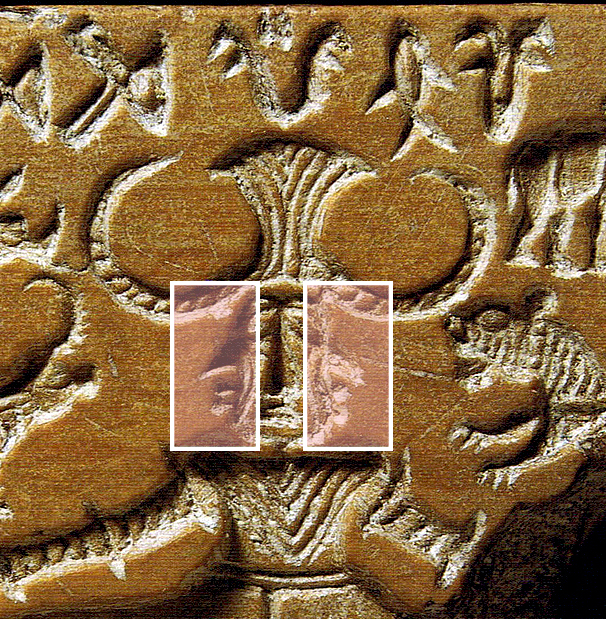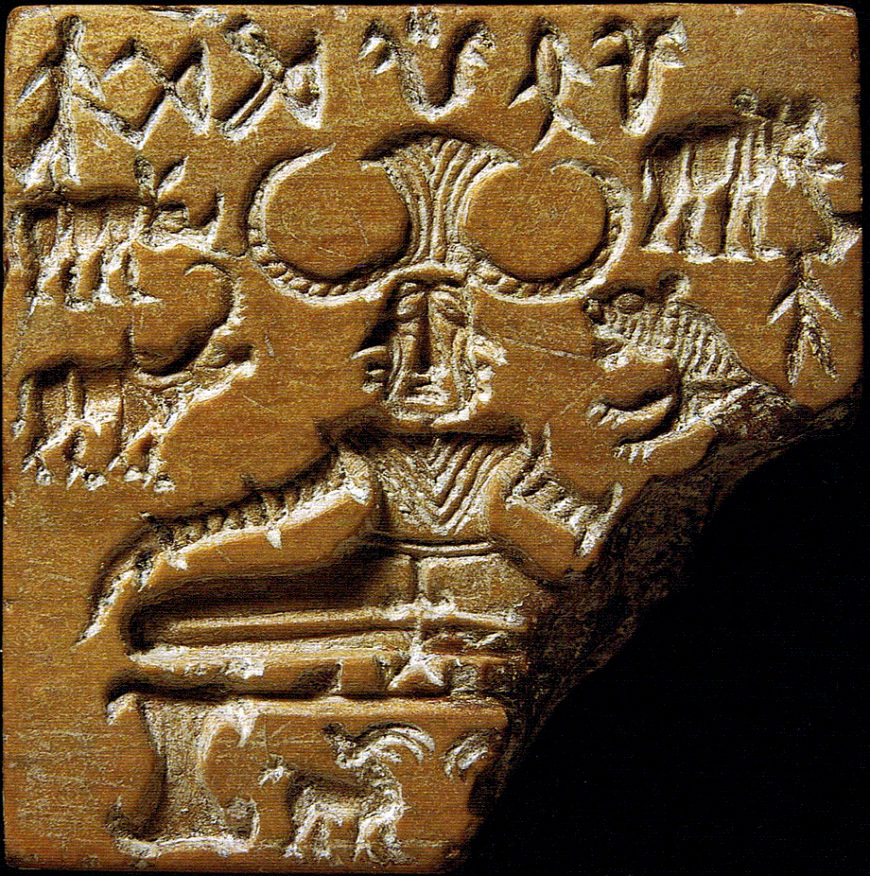
Seal, 2500–2400 B.C.E., steatite, coated with alkali, and baked, Mohenjodaro, Indus Valley Civilization (National Museum New Delhi)
Incised on this small stone (less than two inches across), we see a large figure seated on a dais surrounded by a horned buffalo, a rhinoceros, an elephant, and a tiger. Beneath the platform is a small antlered deer that is one of a pair. Although the deer on the right has broken off at some point, enough of its antler remains to determine that the deer has its head turned away from the center and, like its partner, was looking out towards the edge of the seat. An inscription (as yet untranslated), has been carved into the very top of the seal, with one symbol apparently displaced to the space between the elephant and the tiger. The stone seal, which would have been pressed onto a soft base such as clay to create a positive imprint, is dated to c. 2500–2400 B.C.E. and was found in the archaeological site of Mohenjo-daro, in what is now Sindh, Pakistan.
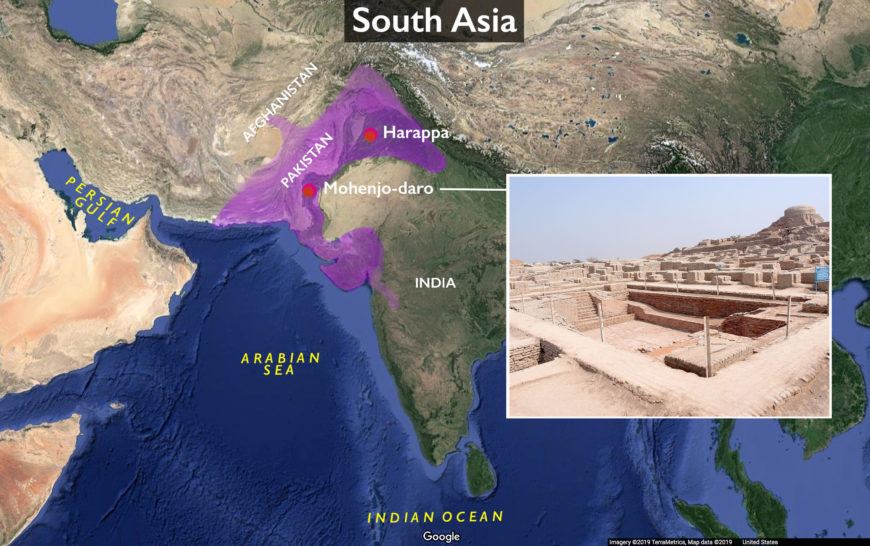
Map showing Mohenjo-daro and Harappa, two of several major sites of the Indus Valley Civilization (area marked in purple). Inset: Mohenjo-daro (photo: Saqib Qayyum, CC BY-SA 3.0)
Imprints of an ancient civilization
Mohenjo-daro was one in a series of settlements that is collectively known as the Indus Valley Civilization. Named after the Indus River, this early civilization encompassed a vast swath of present-day Pakistan and northwestern India. Mohenjo-daro had an estimated 40,000 residents and was a well-planned settlement with efficient urban facilities that included street drainage, a sewage system, and large civic buildings. Residents also had access to well-water and many had baths in their homes.
Seals numbering in the thousands have been discovered in excavations of Indus cities as well as in sites in the Persian Gulf in southwest Asia. Seals from the Gulf region have similarly been found in Indus cities. The finds suggest active trade and exchange between these areas in the third millennium B.C.E.
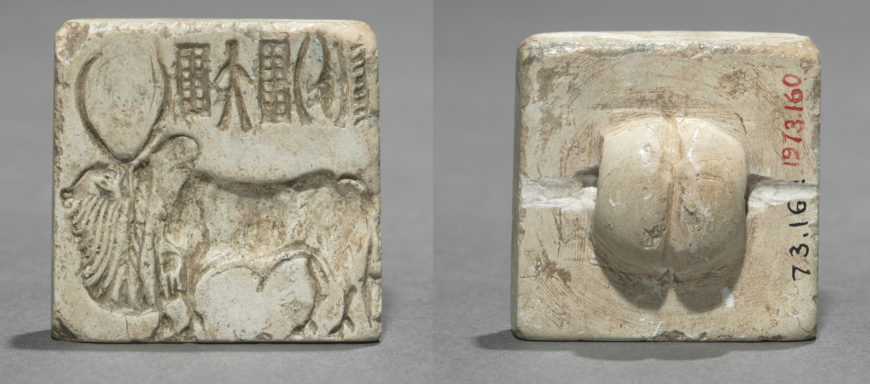
Front and back of seal with two-horned bull and inscription, Indus Valley Civilization, c. 2000 B.C.E., steatite, 1 1/4 x 1 1/4 inches (Cleveland Museum of Art)
Seals often feature a single, large animal such as buffaloes, rhinoceroses, and elephants. The animals are always shown in profile and sometimes standing alongside feeding troughs. Unicorns (that is, animals with a single horn), are also seen on Indus seals, as are trees and animals with a single body and multiple heads. On the rear of the seals is a single and centered rounded projection (see above) with a bored hole with which the seal could be strung.
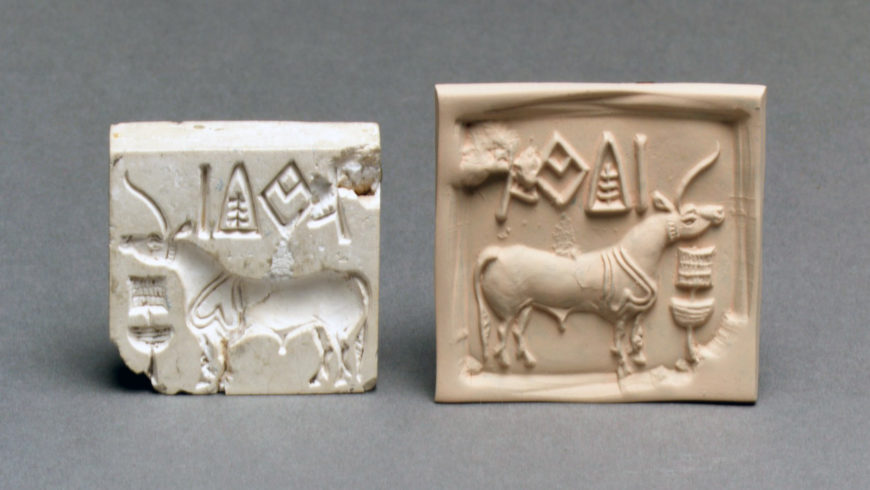
Stamp seal (left) and modern impression (right): unicorn, c. 2600–1900 B.C.E., burnt steatite, 1 1/2 x 1 1/2 x 3/8 inches (The Metropolitan Museum of Art)
Reading Indus seals
The seals include inscriptions in the form of pictograms that unfortunately we cannot yet read; the Indus Valley script is yet to be deciphered. Scholarship has been able to determine, however, that most seals were likely important components of trade. Clay sealings (the positive imprints of the seals) have revealed traces of rope that suggest that they may have been used to brand fastened bundles of merchandise. It has also been theorized that the inscriptions on the seals indicate ownership and that the animals are emblems that referenced particular persons and merchant guilds.
Lord of the beasts
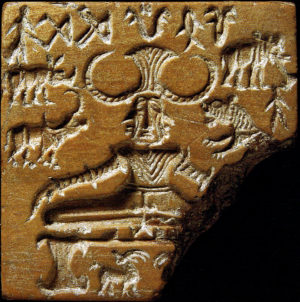
Seal, 2500–2400 B.C.E., steatite, Mohenjodaro, Indus Valley Civilization (National Museum New Delhi)
The figure’s frontality and symmetry demands deference, as does its impressively large and deeply curved horned headdress. The face is long, with a prominent nose, deeply set eyes, and a closed mouth. The figure wears what looks like several necklaces over the chest as well as bangles and bracelets along the length of the arms. There appears to also be a belt at the waist with a tassel, but it is unclear what, if anything, is worn below the waist. The legs are elongated and, even folded at the knee, occupy the length of the seat. The right arm falls gracefully towards the knee, but does not touch it. Based on other examples of this general type of seated figure, we can imagine that the left hand was similarly positioned.
The figure has been described by scholars variously as male, female, with multiple heads, and not. It is also most frequently described as the Pashupati seal, after an epithet for the Hindu god Shiva that means “lord of beasts.” The figure’s apparent mastery over wild animals is thought to be implied by the type of animals — that is, the buffalo, rhinoceros, elephant, and the tiger — included in the seal.
The pair of relatively smaller stylized deer below the figure appear to be different in conception from the other animals. But questions remain: Is this a narrative scene that shows deer gathered at a site? Or are the deer meant to be understood as designs on the dais? The other animals, in contrast, are far more prominent and their importance to the seal’s messaging is evident. They are powerful animals and as if to emphasize this point further the tiger is shown rearing, with its mouth open (while the seated figure appears unfazed).
An early form of Shiva?
Early scholarship [1] posited that the figure in the seal was an ancient Vedic form (named Rudra) of the Hindu god Shiva. This theory was based in part on the following:
- The animals in the seal imply the figure’s dominion over animals and that an epithet of Rudra – Pashupati, the lord of animals – is similarly an epithet of Shiva.
- The figure is seated in a yogic pose (in particular with heels together) and an aspect of Shiva is known as Yogisvara – the supreme yogi (practitioner of yoga).
- A supposition that the figure has three faces as opposed to just one and Shiva is sometimes represented in sacred art with three or more faces.
The substantial chronological gap between the date of the seal (third millennium B.C.E.) and the date of the Vedas (second millennium B.C.E.) should also be noted, although this does not necessarily preclude the inclusion of older traditions in the sacred Vedic texts. There are other major points to be considered, however, that complicate an identification of the figure as a type of proto-Shiva.
- The link between the seal’s iconography and the Vedic themes that have been used to support the Pashupati and Rudra-Shiva thesis are indeterminate. [2]
- Yoga was likely known and practiced for centuries before it was codified into a series of prescribed mental and physical exercises in the second century B.C.E., but it is unclear if the figure in the seal is in fact an early representation of the practice of yoga.
- The presence of lateral faces on the figure is not accepted by all scholars; it is uncertain if the sharp protuberances on either side of the figure’s head indicate facial features. In addition, representations of Shiva with three or more faces have so far only been dated to the much later (medieval) period; see the multiple faces of Shiva as Sadashiva carved in the sixth century here, for example.
Iconographic symbolism
It is evident from the figure’s controlled and meditative bearing that we are witnessing a type of principled self-discipline and asceticism that calls for reverence. Taken with the careful design of the seal — in particular, the primary place of importance given to the main figure, their throne-like dais, regal adornment and frontal pose, and the subsidiary positioning of powerful animals — it is clear, that the seal would have held great symbolic and reverential import for its owner.
Although our inability to read the inscription on the seal undermines our understanding of the intended purpose and meaning of the seal, its iconography bring us a step closer to understanding the people of the Indus Valley Civilization and their rich spiritual culture.
Notes:
[1] See “Male god, the proto-type of the historic Shiva,” in Mohenjo-daro and the Indus Civilization, vol 1, edited by John Marshall (London: Arthur Probstain, 1931), pp. 52–56.
[2] See Doris Srinivasan, “The So-Called Proto-Siva Seal from Mohenjo-Daro: An Iconological Assessment, Archives of Asian Art 29 (1975/1976), pp. 47–58. Based on a study of pre-Indus and Indus period material culture, Srinivasan has forwarded the alternate possibility that the figure represented on the seal may be a “divine bull-man” and that the inclusion of the animals on the seal is indicative of an invocation for a successful hunt. Srinivasan, ibid., p.57.
Additional resources:
Vidya Dehejia, Indian Art (London: Phaidon Press, 1997).
John Marshall, ed., Mohenjo-daro and the Indus Civilization, vol 1, edited by John Marshall (London: Arthur Probstain, 1931).
Romila Thapar, Early India: From the Origins to AD 1300 (Berkeley and Los Angeles: University of California Press, 1997).
Doris Srinivasan, “The So-Called Proto-Siva Seal from Mohenjo-Daro: An Iconological Assessment, Archives of Asian Art 29 (1975/1976), pp. 47–58.
More on the Indus Valley Civilization

